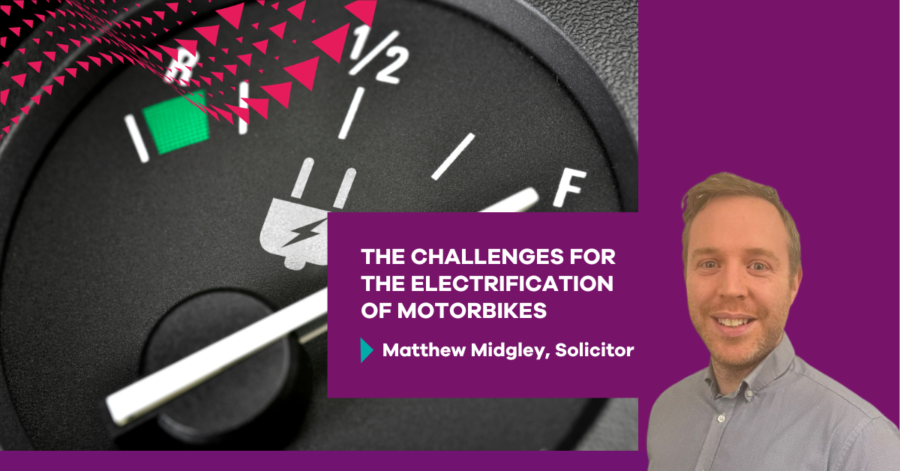
Following our recent review of the charging structure for electric vehicles in the UK, Matthew Midgley, solicitor and Bike team leader, discusses the challenges for electrification of motorbikes.
In 2020 the government announced the end of the sale of new petrol and diesel fuelled cars and vans by 2030. There is obviously still some time until this comes into effect, but it has led to a lot of time and expense being incurred by car and van manufacturers to improve battery technology. This will mean technology will improve immeasurably again in the next 8 years to provide consumers with plenty of options going forwards.
The car and van market has the potential to succeed, as there is plenty of space in those vehicles to store larger batteries. This means larger mileage capacities without the need to charge, but where does this leave the bike market?
In 2021, the Department for Transport (DfT) also announced that from 2035 “all new L-category vehicles to be fully zero emissions at the tailpipe”. The L category, or Powered Light Vehicles, incorporates 2 and 3 wheeled vehicles as well as quadricycles.
There had been hope that motorcycles might remain outside of this ban, due to the relatively minor numbers on the road. The DfT quashed this hope however by explaining in their report that they did not intend for motorbikes to remain fossil fuelled whilst other vehicles on the road transitioned to electric.
All in all, there is nowhere to hide from the fact that the government proposal for carbon neutral vehicles is in full force, and the motorcycle market has some way to go to prepare for the changes over the next 13 years.
Minster Law has spoken to several bikers and manufacturers over the last couple of years to get a sense of how people feel about going electric, and the market as a whole. One answer came up time and time again – what will the mileage limit be before having to source a specific charging point?
For those who commute around a city or town, this is perhaps manageable. But what about those who like to utilise the nice weather and enjoy a weekend touring the countryside, or going on longer journeys? Are they going to be able to make the 50-100 mile round trip down the motorway to commute to and from work without having to find a charging point?
The good news around charging electric bikes, unlike their car and van equivalents, is that they can charge from a standard UK 3 pin socket, just like a mobile phone or a laptop. One word of warning however, lies in the fact that over time, different companies have been involved in electric charging which means that there are different charging points and sockets available, much like there is with different mobile phones from different manufacturers, and not all are cross compatible.
In addition there are 3 charging speeds in the UK – slow, fast and rapid, which brings different charge times for different bikes, so charging can take from one hour to 12 hours.
The choice really comes down to the individual and finding an electric bike which suits their needs. Can you compromise on power or size, to increase range? Is this going to prevent you from enjoying a weekend ride around the countryside?
Whatever happens, there is a lot of work to do on technology to allow for a wide enough variety of bikes being offered, and that’s before we even mention the infrastructure around the country of sufficient charging points. For further information, our review of the current charging structure in the UK goes into more detail.



